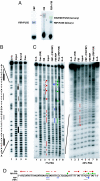Hierarchical mechanisms build the DNA-binding specificity of FUSE binding protein
- PMID: 19015535
- PMCID: PMC2587613
- DOI: 10.1073/pnas.0803279105
Hierarchical mechanisms build the DNA-binding specificity of FUSE binding protein
Abstract
The far upstream element (FUSE) binding protein (FBP), a single-stranded nucleic acid binding protein, is recruited to the c-myc promoter after melting of FUSE by transcriptionally generated dynamic supercoils. Via interactions with TFIIH and FBP-interacting repressor (FIR), FBP modulates c-myc transcription. Here, we investigate the contributions of FBP's 4 K Homology (KH) domains to sequence selectivity. EMSA and missing contact point analysis revealed that FBP contacts 4 separate patches spanning a large segment of FUSE. A SELEX procedure using paired KH-domains defined the preferred subsequences for each KH domain. Unexpectedly, there was also a strong selection for the noncontacted residues between these subsequences, showing that the contact points must be optimally presented in a backbone that minimizes secondary structure. Strategic mutation of contact points defined in this study disabled FUSE activity in vivo. Because the biological specificity of FBP is tuned at several layers: (i) accessibility of the site; (ii) supercoil-driven melting; (iii) presentation of unhindered bases for recognition; and (iv) modular interaction of KH-domains with cognate bases, the FBP-FIR system and sequence-specific, single-strand DNA binding proteins in general are likely to prove versatile tools for adjusting gene expression.
Conflict of interest statement
The authors declare no conflict of interest.
Figures





References
-
- Smogorzewska A, de Lange T. Regulation of telomerase by telomeric proteins. Annu Rev Biochem. 2004;73:177–208. - PubMed
-
- Kouzine F, Sanford S, Elisha-Feil Z, Levens D. The functional response of upstream DNA to dynamic supercoiling in vivo. Nat Struct Mol Biol. 2008;15:146–154. - PubMed
-
- Lavelle C. DNA torsional stress propagates through chromatin fiber and participates in transcriptional regulation. Nat Struct Mol Biol. 2008;15:123–125. - PubMed
-
- Iftode C, Daniely Y, Borowiec JA. Replication protein A (RPA): The eukaryotic SSB. Crit Rev Biochem Mol Biol. 1999;34:141–180. - PubMed
-
- Braddock DT, Louis JM, Baber JL, Levens D, Clore GM. Structure and dynamics of KH domains from FBP bound to single-stranded DNA. Nature. 2002;415:1051–1056. - PubMed
Publication types
MeSH terms
Substances
Grants and funding
LinkOut - more resources
Full Text Sources
Other Literature Sources
Research Materials
Miscellaneous

